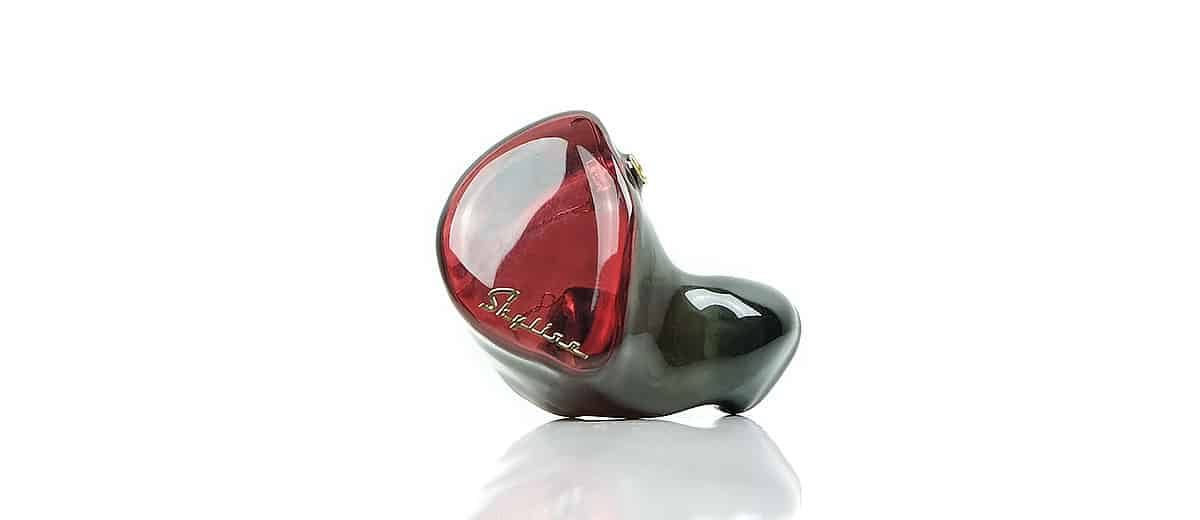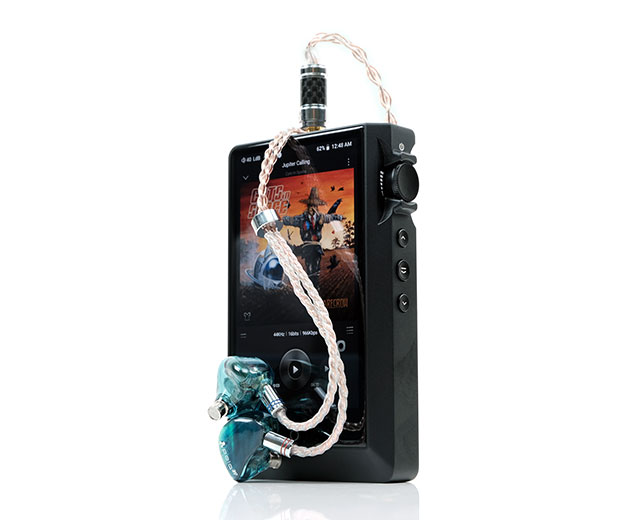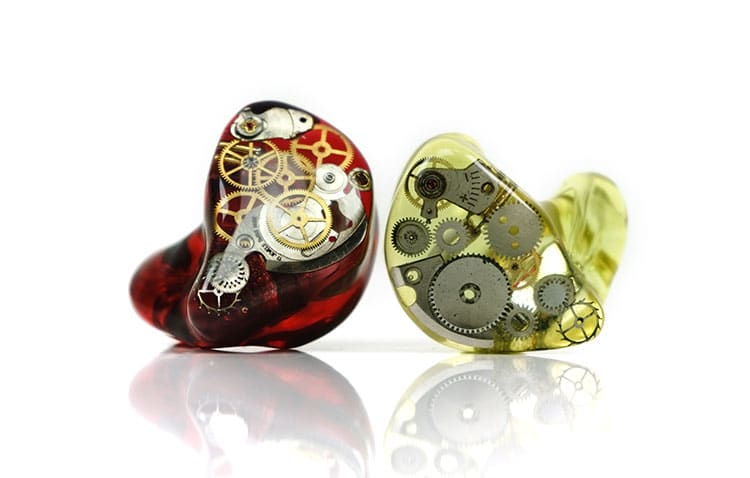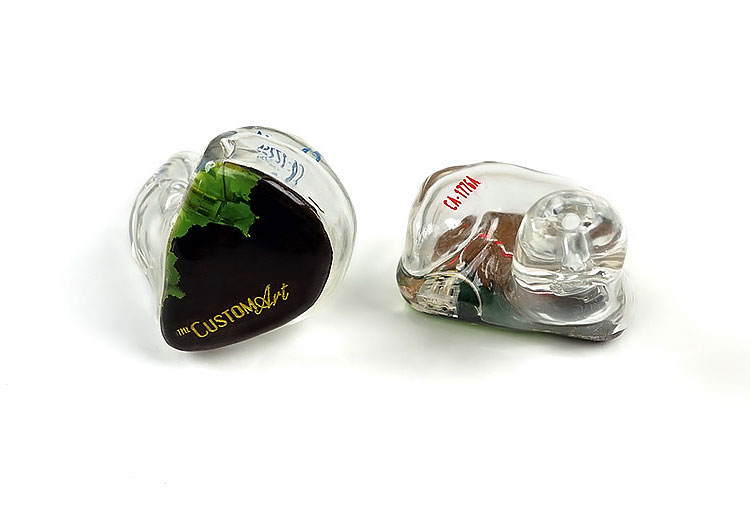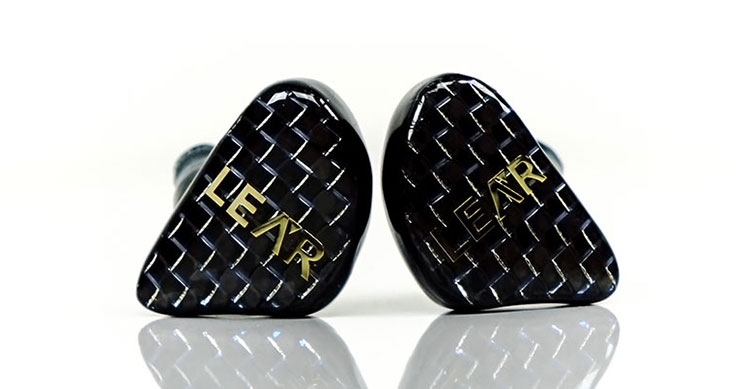Sound Impressions
Summary
The LCM-Skyline is a thick, rich and euphonic dynamic driver sound signature with an excellent low-end body and a forward vocal signature. I would say it veers to the lush side a little with a fairly relaxed treble sound that tends to fade away from 4-5k with just a minor bump at 8-10k but many dB lower in amplitude to that mid-to-upper mids bumps.
As such it lacks a bit of sparkle creating instead a darker sound signature but one that is impressively more detailed and clearer sounding than the older LUF-Turbo when we did the comparison work further down in this review. The key to this is the midrange which is relatively bumped and balances out the low-end weight nicely to create a relatively pleasing balance.
This is a forgiving sound signature but importantly the low-end is just leveled off enough on its sub-bass presence to prevent irritating bloat and a mushy midrange.
It also sounds more detailed and controlled than I expected a monitor at this price point, much more so given this is also a custom design that has a higher production cost.
Staging
The staging here has more of a focus on depth and weight with excellent power on lower pitching instruments. Vocals are positioned a little further forward with that midrange bump so the imaging is stretched a little from front to back but without instruments sounding thinned out and lacking in presence.
The bass fundamental with the LCM-Skyline is excellent and there is no shortage of power and authority on kick drums and bass guitar rhythm sections. The weak are of the LCM-Skyline is the lack of air and that relatively darker tone the further up you go. It lacks a bit of height so beyond vocals percussion presence is pushed back and lacking in presence.
Bass
I suspect this is what is going to draw you first to the LCM-Skyline sound signature and it has all the classic traits of a nicely tuned big-sounding dynamic driver.
The elevation and drop from 40Hz to the lower mids around 500hz are fairly well sustained. Sub-bass presence is slightly leveled off so it is not so dominant but you do get some excellent body, plenty of texture, and warmth to the low-end but slightly less rumble than the LUF-Turbo.
Still, the perception of depth is excellent and the bass fundamental strong for low-pitching instrument notes which is much better than I was expecting.
The decay is fairly long as you would expect from a dynamic driver so the pace is a touch languid but it sounds more balanced to me than the LUF-Turbo which felt a little disconnected in comparison.
Mids
From 500hz to 1k there is a minor drop which does help with instrumental clarity and prevent the mids from sounding congested. From 1-4k there is a fairly sustained rise so vocals tend to pick up a forward presence on the LCM-Skyline.
I kind of like that since it helps keep the bass presence in check a bit more and prevents a veil from falling over the general sound signature which could have been quite off-putting. This is one area I noticed that visibly outperforms the LUF-Turbo whose vocals can sound a little flat and hollow in comparison.
The instrumental timbre does carry a fair bit of low-end warmth up with it into the mids. Combined with the relaxed treble presence the harmonic balance is definitely on the creamy and wet side.
That means plenty of body, richness, and smooth delivery but those who like a more neutral sound signature might find those rounded notes lacking in a little clarity and air.
Treble
Beyond 4k, the treble of the LCM-Skyline starts to fade away and that minor bump from 8-10k helps a little but not enough to prevent the overall sound signature from being considered a little on the darker side of the spectrum.
What does that mean? Well, the treble body is just excellent, the texture is rich, and you will be hard-pressed to find a single peaky and harsh overtone on the LCM-Skyline top-end. However, you might find yourself wanting a bit more headroom and air, especially for percussion and vocals which sound dense and close.
You can DSP that treble top-end via HiBy’s MSEB and any decent PMEQ and I do suggest you try it as it can add a bit of clarity and bite to percussion timbre. I tend to revert to DSP just to add a bit more treble/bass contrast to the LCM-Skyline top-end. Stick with the stock presentation however if you much prefer a forgiving and smooth treble performance.
Synergy
Efficiency
The LCM-Skyline is rated at 16Ω and 109dB and I would place it around the medium level in terms of efficiency. It will not require huge power to get going and a moderate source will drive it fairly well.
Current demands are a bit higher but it is more efficient than the older dual dynamic driver LUF-Turbo. Hiss on higher noise floors DAPs are not an issue either and sounded nice and quiet on the Cayin N6ii, FiiO M11, and the HiBy R6 Pro.
Synergy
No doubt in my mind that given the lush, rich, and slightly dark overtone of the LCM-Skyline you will want to be pairing this with a source or amp stage that is more on the neutral to revealing side. The last thing you want is a tube-like pairing to butter it up even further.
Perhaps the best pairings then were the FiiO M11 and the HiBy R3. Now both are clean with good treble articulation and paired well with the warmer LCM-Skyline to give me plenty of detail I was looking for.
However, it was really the M11 that was the perfect pairing at the mid-fi price point. It doesn’t spit out too much bass and tends to give off a neutral to slightly bright top-end with most monitors in comparison to the thicker punchier sound of the HiBy R5.
That kind of pairing charmed me with the LCM-Skyline and blew away much cheaper DAPs such as the Sony A35 which sounded way too dark and unresolving. The M11 kicked in some much-needed air and pushed the treble quite well with the LCM-Skyline and that’s what I wanted to hear. A bit more balance and slightly less ‘dark’.
I was able to get a similar synergy with the flagship Lotto PAW Gold Touch but on a much more resolving level with some excellent dynamic range. However, I suspect a $210 DAP is not going to be paired with a $4k DAP that often so more of an esoteric experiment than an everyday occurrence. Still, the pattern is set. Neutral, clean DAPs pair very nicely with the LCM-Skyline.
DSP
If you are using HiBy’s excellent MSEB DSP settings in either the R5, R6 Pro or the Cayin N6ii then you can tweak away and the LCM-Skyline will respond nicely.
If you wanted something a little cleaner without going into sibilance territory I would suggest moving the cool bright slide marginally and then compensating with a slightly faster bass DSP setting. Detox the female vocals a tiny bit and add some crispness to the air setting.
This is mainly for the Cayin N6ii and A01 motherboards. You will lose a little bass power but in return, you get a bit more sparkle and space around those vocals. The timbre is also a little lighter, cleaner, and sweeter as opposed to richer and full-bodied.
Select Comparisons
Avara Audio AV3
$310
Technical
The Avara AV3 is a triple BA driver custom monitor and our Bang For Buck CIEM award winner for 2018. The configuration holds no surprises with a single BA each for the lows, mids, and highs using a 3-way crossover.
A key difference in the AV3 driver configuration is the low-end BA being one of the bigger CI series of Knowles drivers. The AV3 also uses a dual-bore design as opposed to the single 8mm dynamic driver single-bore setup of the LCM-Skyline.
Another difference between the two custom units is the venting system. The LCM-Skyline uses an acoustic filter pressure venting system to reduce potentially damaging air pressure on your eardrum as well as allow the dynamic driver to breathe.
The AV3 does not have venting or an air-pressuring filter system. The flip side is that the lack of venting means that the AV3 seals better, (assuming your ear impressions and mold are an exact fit).
The other attractive feature of the VA3 is the company’s site designer. It is tidy, organized, and easy to use and allows you to flex your creative control on the final design. Something which I would love Lear to do on their site.
Performance
The Avara AV3 is rated at 50Ω and 120dB which is a slightly unusual combination of numbers since these days we are more used to sub 30Ω with that kind of SPL. This is more likely due to the large vented subwoofer driver underpinning the AV3 performance driving up the resistance level.
Mind you both the LCM-Skyline and the AV3 present no real driving issues. However, the current demand gap or volume requirements as indicated by that 11dB SPL gap is fairly substantial. The LCM-Skyline requires almost 25 steps more in unbalanced on the FiiO M11 compared to the AV3 and 5-6 steps minimum on the Lotoo PAW Gold Touch unbalance.
You will also pick up hiss a bit quicker on the AV3 though to be fair it was not that noticeable on the M11, more so on the older X5iii. The LCM-Skyline lower level of efficiency means it is pretty quiet on both sources with no perceptible hiss.
Tuning
Both of these monitors veer to the musical and euphonic in their timbre and tuning emphasis but they take very different approaches to achieve that.
The AV3 is lighter on the low end with more mid-bass warmth and definitely a BA timbre in its punchy but less rumbly bass response. The LCM-Skyline is thicker, and richer with that natural dynamic driver sub-bass extension and power though not overdone for me.
As a result, the LCM-Skyline has better depth for me, and instruments benefit from a better bass fundamental as a result.
Now the mids are a little different in that timbre, partly due to the added richness and warmth the LCM-Skyline bass delivers but also due to that rapid roll-off from 4-5k onwards taking a lot of odd-harmonic overtones out. It is smooth and euphonic but perhaps a shade on the darker side and not as airy compared to the AV3.
The AV3 has an equally forward vocal and an intimate midrange and its upper treble is not that extended either. However, its lower treble elevation does not roll off quite so early, say about 6-8k you see it fade away.
As a result, you get a slightly cleaner overtone on instrumental and vocal timbre on the AV3. Instead of a rich and thick sound, you get a lighter sweeter tone and a bit more bite and articulation in percussion timbre.
Custom Art FIBAE 1
€300
Technical
The FIBAE 1 was the first custom monitor in the FIBAE range to launch using a single balanced armature driver, a horn nozzle design, and a vented receiver for improved bass response.
The concept of FIBAE is to render impedance mismatching between the source/amp stage and the driver moot.
That means DAPs like the R6 with its 10Ω output jack impedance will not skew the response curve of the FIBAE 1 and it should sound exactly as it should. Normal drivers may lose bass weight or sound too dark depending on the design, the FIBAE 1 should not suffer from those variations.
Like Avara, Custom Art also has an edge over Lear with its design approach online. It is integrated with a simulation model for the checkout process which gives you plenty of flexibility. The add’s on are pretty cheap also but Lear is not that pricey either if you know where to look for the options.
Performance
The FIBAE 1 is rated at just 5.1Ω and 109dB SPL. That, on paper, is a very unusual impedance rating but it is fairly symbolic of the entire FIBAE range (5 models) with their ultra-low impedance rating. It plays no part really in how it reacts to impedance output ratings. The key is the SPL at 109dB which is the same on-paper rating as the LCM-Skyline’s 109dB SPL.
In our real-life testing, we actually found the FIBAE 1 to be the more efficient and in some cases by a large margin. On the Lotoo PAW Gold Touch unbalanced there was about 3-4 steps volume gap and not so much twiddling.
However, on the unbalanced output of the FiiO M11, we had to go almost 20 steps suggesting not only was the LCM-Skyline a little less efficient but probably also can scale better with more power.
Tuning
Classic BA versus dynamic driving timbre on the low-end between these two. The FIBAE 1 is the more neutral of the two though overall, I find it more on the natural side with a slight mid-bass rise but an otherwise tight and punchy low-end with a fast decay.
The driver in the LCM-Skyline has a slower pace to its low-end with a longer decay but also a lot more body, sub-bass presence, and power.
The LCM-Skyline also has its fair share of warmth and a bit more than the more neutral timbre of the FIBAE 1. The LCM-Skyline is more even-harmonic, euphoric, and creamier in its mids presentation with big and smooth, and forward vocals.
The FIBAE 1 also has a slight bias to female over male vocals but overall, it is more neutral in positioning than the LCM-Skyline. Its timbre is cleaner with a little more focus on articulation than body and texture.
Neither monitors show a tremendous upper treble extension. However, the LCM-Skyline rolls off earlier than the FIBAE 1 so whilst the treble has more body and sounds wetter it doesn’t quite have the same level of contrast as the FIBAE 1’s lower-treble presence on percussion and female vocal timbre.
Lear LUF-Turbo
HK$1,199
Technical
The LUF-Turbo is a universal monitor from Lear’s line-up, a slightly older model at that. However, it is slightly cheaper than the LCM-Skyline and you can get an LCM or custom version for less than the Skyline also.
The Turbo is a dual dynamic driver monitor, so doubles the DD count compared to the Skyline. The two DD”s are 6mm and 9mm with the 6mm covering the highs and mids and the 9mm covering the lows, all tied together with a 2-way crossover. Both use PET diaphragms compared to the PEEK 8mm single DD of the LCM-Skyline.
Physically the LUF-Turbo is tiny compared to the LCM-Skyline though it does not have the LCM-Skyline balanced in-ear pressure filtering system to reduce pressure on the eardrum.
I believe both have venting in the same rear inner shell position, at least on visual inspection they do. However, the LUF-Turbo, being universal, will be more tip dependent on isolation and fit. Overall, the LCM-Skyline custom is the better fit with more isolation but the isolation of both is average due to the venting.
Performance
The LUF-Turbo is rated at 20Ω and 106dB SPL so not that far off the LCM-Skyline’s 16Ω and 109dB. Both will drive fairly easily off moderate sources and both are fairly resistant to background hiss from higher noise floor amp stages from the likes of the FiiO M11 and the Cayin N6ii. Even the R2R2000 Red sounds fairly well behaved with both for noise.
The slight difference will be in current demand with that 3dB gap with the LCM-Turbo requiring slightly more volume matching than the LCM-Skyline.
That performance level pretty much played out as we expected with our test DAPs, the Lotoo PAW Gold Touch and the HiBy R5 with about a 2-3 steps gap in volume between both monitors using unbalanced. Neither, by the way, have any issue with background hiss.
Tuning
Both of these monitors are aiming for a kind of warm and smooth even-harmonic biased timbre with more low-end and mids emphasis and reasonably relaxed treble. That’s the high-level description.
However, the tuning emphasis is different and yes, the LCM-Skyline sounds more balanced with a better midrange and vocal performance and what seems to be a more linear yet still full-bodied low-end.
Perhaps one of the aspects of not only going from 2 to 1 dynamic driver but reducing it from 9mm to 8mm has allowed Lear to tighten up the low-end, and tone down Turbo’s heavier sub-to-mid-bass presence.
That single driver also does not sound quite as disconnected as what I am hearing on the crossover dual-driver Turbo. I enjoy the more bombastic tuning for the Turbo for EDM but it is not quite as balanced nor does it have the clarity and detail on vocal and percussion performances quite like the LCM-Skyline.
To be honest, the LCM-Skyline vocal clarity and better harmonic balance often made the LUF-Turbo sound slightly veiled and lacking in the air by comparison. For me, that 1-4k rise on the LCM-Skyline creates more pop and complexity in the soundstage compared to the flatter LUF-Turbo which only has a minor 1-2k bump.
These two are solid evidence that multi-driver IEMs do not always mean a better sound than a single-driver build.
Our Verdict
Honestly, at just over $200 the Lear LCM-Skyline is a bargain and if you are into a warm, lush, and rich-sounding dynamic driver sound this should be right up your alley. The introduction of the Combo-Con MMCX connectors should also ensure they last for a really long time without issues making these a strong investment for not so many greens.
I would love to see more design combos and a more integrated website to support design possibilities but otherwise, the quality of the build is very good and equal to many monitors that will cost you a lot more money.
With the LCM-Skyline, you are going to feel like you got a lot of performance and quality for the price which is rare these days. Kudos to Lear for what I think is a solid ‘bang for buck’ custom monitor with a very forgiving and musical sound signature.
Lear LCM-Skyline Specifications
- Driver: 8mm dynamic driver with PEAK diaphragm
- Frequency Response: 15Hz-50kHz
- THD: ≤0.2% @1000Hz
- Impedance: 16Ω @1000Hz
- Sensitivity: 109dB @1mW

